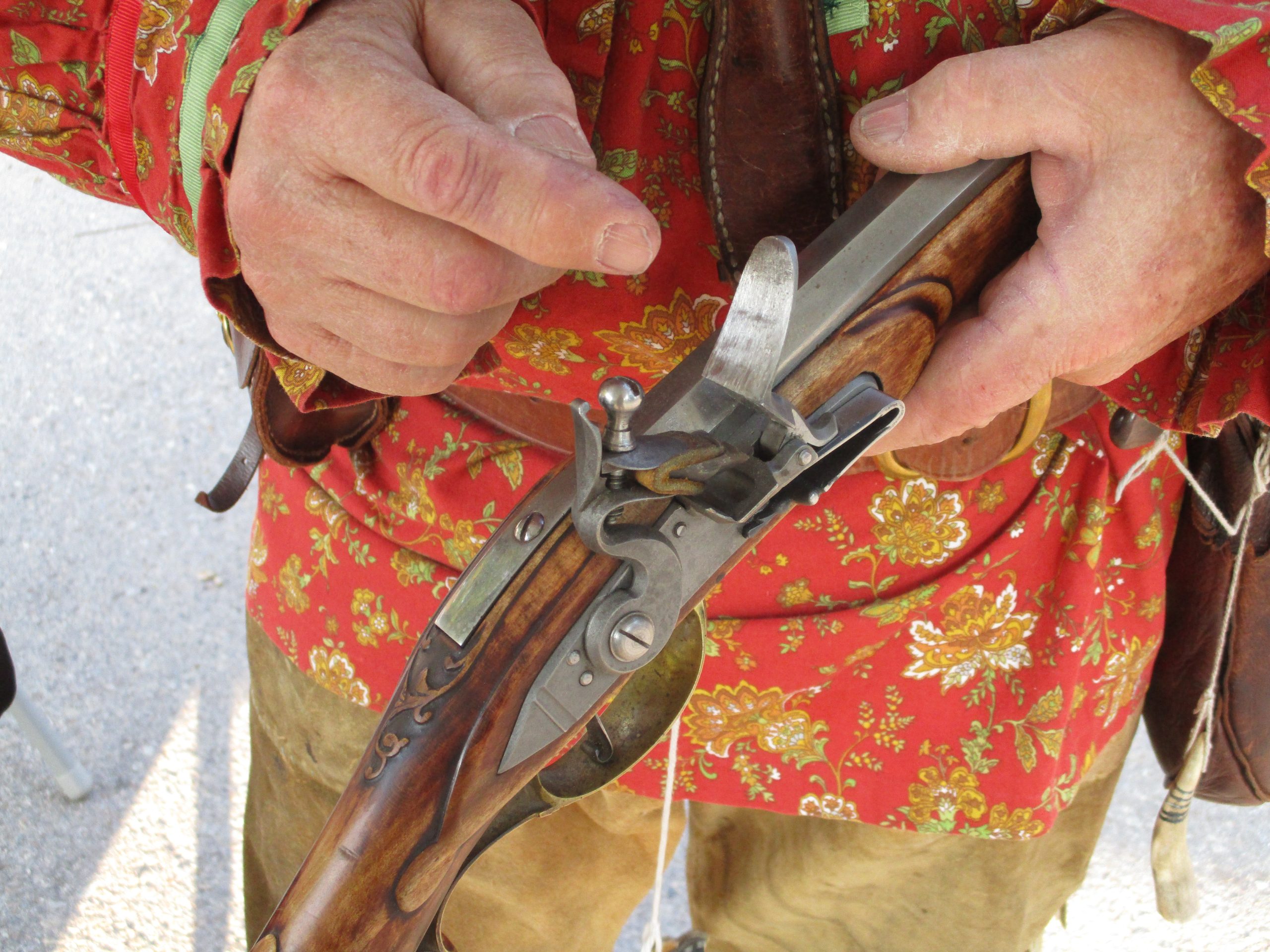Some information may be outdated.
Grand County Commissioner Greg Halliday wears several hats: in addition to the duties of his elected office, he volunteers as a firefighter in Castle Valley, where he lives, and sits on various boards, including the Moab Museum board. On Sept. 17, Halliday was wearing a felt hat circa the mid-1800s, along with other period clothing representing a storied figure of American history: the mountain man of the West.
Halliday was sharing his passion for the fur-trapping era of the United States with browsers at the last Market on Center event of the season, manning a table sponsored by the Moab Museum. In addition to the felt hat, he wore a beribboned shirt in mountain-man style, handmade by his wife; leather pants he made himself in 1986; and a pair of leather moccasins, also made by himself.
On his shoulder he had a leather bag designed to hold paraphernalia needed to operate a muzzle-loaded rifle, which he also had at hand, as well as a powder horn crafted from a cow horn and full of real black powder. The leather bag, the horn, even the functioning flint-lock rifle, circa 1770—Halliday made them all himself.
“I like the history of the United States, just in general,” Halliday said in explaining the appeal of the hobby. “I know there’s a lot of bad things—the way the English treated the Scots, the way the English treated the Irish—not discounting how the Americans treated the Indians, which was genocide. But I try to look at the positive aspects of it.”
Halliday isn’t alone in his interest. Mountain Man Rendezvous, re-enactments of the historic gatherings where fur-trappers, tradesmen, and Native Americans would trade goods, hold competitions and revel together, take place all over the West each year. They enjoy reuniting at events and have developed rituals like assigning nicknames. Halliday earned the nickname “Pretty Flint,” in reference to the hand-knapped flint on his rifle.
“Some mountain man names are not flattering,” Halliday said, describing a friend who earned the nickname Skunk Britches and another nicknamed Ramrod.
The modern events have spread beyond the region of their inspiration. The original rendezvous, Halliday said, happened between 1825 and 1840, and took place mostly in Idaho, Wyoming, and northern Utah.
Evidence of a French trapper in the Moab area is documented in a rock carving in a side canyon of the Green River, north of Canyonlands National Park. The inscription reads “D. Julien 1836 3 Mai.” Halliday said the author of the inscription was probably exploring the area, and though beaver were plentiful, other game trappers needed to sustain themselves, like bison and elk, were scarce. There was probably little trapper activity in this part of Utah during the heyday of the fur trade.
Halliday can’t pinpoint exactly when or how he got interested in being a modern-day mountain man. He is an Eagle Scout in the Boy Scouts, which he thinks may have piqued his interest in outdoor skills. In the 1970s, he got a bachelor’s degree in anthropology and joined the National Guard. In the 1980s, he said he “got an itch” to make leather clothing, and sewed the pants he still wears, but he put the hobby aside when he went on active duty in the Army. Halliday trained in the United States and later traveled throughout Central America as part of a medical unit conducting “Medical Civic Actions” to promote good will in those countries and provide training for American personnel. Later he was stationed at the Pentagon as a senior adviser, and was there on Sept. 11, 2001, when the building was attacked by terrorists.
“Not a good day,” Halliday recalled.
He later returned to Utah, where he was born and grew up, and he and his wife found property in Castle Valley, close to where they used to camp in Onion Creek. Halliday bought five acres there in 2003, and retired from the Army in 2005.
Around the same time, he returned to his interest in mountain man activities, attending his first rendezvous in 2004. He began serving on the County Council in 2017, and volunteered to serve on the Moab Museum board. His adult son and daughters now enjoy joining him at rendezvous, though Halliday says he’s still the one who makes all the guns. He has crafted five rifles and some smaller guns in historical styles. He can speak at length about the details of the mountain man lifestyle, events of the period, and the nuts and bolts of historical tools and equipment.
“That’s what I’m into,” he said.
County commissioner’s alternate persona: American mountain man
Appreciate the coverage? Help keep local news alive.
Chip in to support the Moab Sun News.





